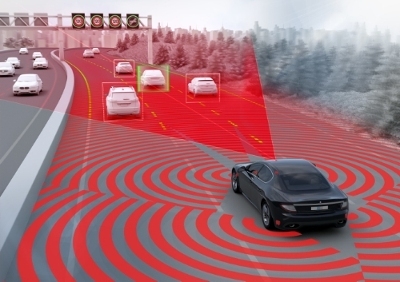ZF TRW Highlights Why Automated Driving Starts with Safety at IAA Exhibition
 Accurate 360 degree sensing of the vehicle environment is critical to the partially and fully automated systems of the future. For complicated highway and city traffic scenarios a suite of camera and radar sensors will be needed to sense and differentiate key features such as other vehicles, traffic signs and lights, pedestrians and cyclists and more. |
ndustry's widest breadth and depth of safety systems form the basis for automated driving systems
- Advanced generations of camera and radar technologies will help accurately sense the surrounding vehicle environment
- ZF TRW longstanding expertise in safety puts automated driving development in the hands of a trusted partner
LIVONIA, MI -- Sept. 21, 2015: ZF TRW, the Active and Passive Safety Technology Division of ZF AG, is uniquely positioned to deliver the automated driving functions of the next decade. One core theme is central to these developments: Safety.
Today's active safety systems are already delivering automated functions in emergency situations such as Automatic Emergency Braking and Emergency Steering Control and ZF TRW is progressively expanding these functions into partially and eventually fully automated driving functions. This is being achieved through highly advanced environmental sensing, more robust and redundant actuators and complex electronic control units housing advanced software.
Peter Lake, executive vice president, Sales and Business Development at ZF TRW commented: "While there are many benefits to be realized from automated driving technologies, the foundation underlying the adoption of these technologies is safety. Drivers will never cede control of their vehicle unless they feel safe to do so. With a product portfolio that is 90 percent safety focused, ZF TRW has the deep experience and expertise to deliver the automated driving functions that drivers, occupants and other road users can trust. And although there are still many challenges to address, road users are already experiencing the immediate safety benefits of these proven technologies as partially automated systems make their way on to the road."
ZF TRW has been a pioneer in the design and development of sensors, electronics, braking and steering technologies and is bringing this experience to bear in developing a range of partially automated driving functions. These include 'Highway Driving Assist' which can enable automatic steering, braking and acceleration for speeds down to 0 kph. As a single lane application, the system combines adaptive cruise control and lane centering to help maintain the lane and a set interval to target vehicles ahead. A multi-lane variant is also in development which will feature 360 degree sensing and enable vehicles to automatically overtake. The same hardware configuration can deliver 'Traffic Jam Assist' functionality for speeds up to 60kph.
Lake continued, "The next decade presents an historic opportunity to transform mobility and the driving experience, and at the heart of that opportunity lies the chance to improve road safety around the globe. This will require auto manufacturers, suppliers and governments to work together with the motoring public to make this a reality, with societal benefits as the prize."
Building blocks of automated driving
Sensors ZF TRW is developing its fourth generation sensors that will significantly enhance advanced safety and automated driving functionality. The S-Cam4 family of forward-looking cameras includes a single lens, mono-camera version based on a standard housing and mechanical package and a premium three lens TriCam4 version to support advanced automated driving functions.
ZF TRW's AC1000 radars will offer 360 degree sensing, and forward looking dual mode functionality for low and high speed applications that can switch automatically depending on vehicle speed. It also utilizes a unique modulation scheme that enables a wider field of view at low speed while maintaining a long range at higher speeds, making the technology relevant for a broader range of applications.
Controllers The central control unit acts as the brain of the vehicle – fusing and processing information from the sensors to engage various safety features for the vehicle occupants and other road users. ZF TRW's second generation safety domain ECU (SDE 2), scheduled to start production in 2018, is a key enabler of automated driving.
Actuators (Braking and Steering) ZF TRW's Integrated Brake Control system offers superior braking performance and ESC capability, and can help meet increased requirements for fuel efficiency/CO2 while supporting regenerative braking across the full range of powertrain configurations, advanced safety systems such as automatic emergency braking and advanced automated driving functions. The company will launch the technology with a major vehicle manufacturer in 2018.
ZF TRW offers two Electrically Powered Steering (EPS) variants – belt drive and column drive. These systems typically yield a 3-4% fuel savings when compared to hydraulically powered rack and pinion steering systems. When integrated with sensors such as video cameras, EPS can provide steering torque support and angle control to help keep vehicles in their lane.


